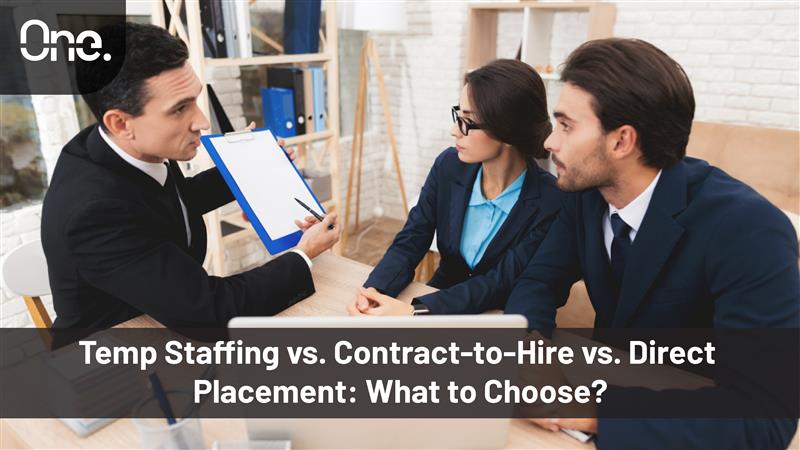In today’s fast-changing hiring landscape, businesses face multiple staffing models, each with its own advantages, limitations, and ideal use cases. Whether you’re scaling a project team, replacing a key employee, or building a long-term department, choosing the right hiring strategy can significantly impact costs, timelines, and outcomes.
In this article, we’ll break down the differences between temp staffing, contract-to-hire, and direct placement. We’ll help you determine which is best suited for your business needs in 2025.
What Is Temp Staffing?
Temp staffing refers to the short-term hiring of professionals to fill immediate needs or temporary gaps. These workers are typically employed by a staffing agency and assigned to your company for a limited time.
Key Features:
- Duration: Usually short-term (weeks to a few months)
- Employer of record: Staffing agency
- Use cases: Seasonal demand, project spikes, employee leave, emergencies
Advantages:
- Speed and flexibility. Quickly fill roles without long-term commitment.
- Reduced legal risk. Benefits, taxes, and compliance handled by the agency.
- Cost control. Avoid the costs of full-time employment when not necessary.
Limitations:
- Lack of continuity. Knowledge may be lost after the assignment ends.
- Training burden. Temporary staff may still require onboarding.
- Limited loyalty. Temps may be less invested in your business outcomes.
Ideal For:
- Retail, customer service, manufacturing, or healthcare companies with fluctuating labor needs.
- Projects with fixed timelines that don’t justify permanent hires.
What Is Contract-to-Hire?
Contract-to-hire is a hybrid model where a candidate works on a temporary basis for a predetermined period before potentially being hired as a full-time employee.
Key Features:
- Trial period: Typically 3 to 6 months
- Employer of record: Agency during the trial, then transitions to client
- Use cases: Assess fit before committing to permanent employment
Advantages:
- Try before you buy. Evaluate performance and cultural fit in real time.
- Less risk. Poor performers can be let go without severance or complexity.
- Faster hiring cycles. Reduces risk aversion for both employer and candidate.
Limitations:
- Delays in building long-term teams. May create uncertainty for both sides.
- Potential for misalignment. Temp contracts may attract those not seeking full-time roles.
Ideal For:
- Roles requiring specific hard skills and cultural alignment.
- Businesses that want long-term employees but with reduced hiring risk.
What Is Direct Placement?
Direct placement, also known as permanent staffing, involves hiring a full-time employee directly onto your team. The staffing agency handles sourcing, vetting, and recruitment, but the candidate is hired immediately as a permanent employee.
Key Features:
- Employer of record: Your company
- Duration: Long-term or permanent
- Use cases: Core roles, leadership positions, specialized technical talent
Advantages:
- Stronger retention. Full-time employees are more invested in the organization.
- Smoother onboarding. Candidates know they’re in for the long haul.
- Stronger team culture. Helps build consistent, collaborative environments.
Limitations:
- Higher upfront cost. Placement fees may be higher.
- Less flexibility. Difficult to reverse poor hiring decisions.
- Longer recruitment cycles. More care required in selection.
Ideal For:
- Executive or leadership roles.
- Companies investing in long-term growth and team cohesion.
Side-by-Side Comparison
| Factor | Temp Staffing | Contract-to-Hire | Direct Placement |
|---|---|---|---|
| Duration | Short-term | Short-term with potential | Long-term or permanent |
| Commitment Level | Low | Medium (conditional) | High |
| Hiring Speed | Very fast | Fast | Moderate |
| Cost | Hourly rates plus agency markup | Contract rate plus conversion fee | One-time placement fee |
| Risk | Low | Medium | High |
| Onboarding Investment | Low | Medium | High |
| Long-Term Value | Limited | Potentially high | High |
How to Decide What’s Right for You
Choosing between these staffing models depends on several internal factors.
1. Business Objectives
- Short-term projects? Choose temp staffing.
- Growth-stage hiring with flexibility? Choose contract-to-hire.
- Building permanent infrastructure? Choose direct placement.
2. Budget and Risk Tolerance
- Want to minimize financial risk? Use temp or contract-to-hire.
- Willing to invest in long-term returns? Use direct placement.
3. Urgency of Need
- Immediate gap to fill? Choose temp staffing.
- Time to test cultural fit? Choose contract-to-hire.
- Ready to invest in strategic talent? Choose direct placement.
4. Internal Resources
- Limited HR capacity? Use staffing agencies.
- Strong internal HR team? Direct hiring may be more efficient.
How One Technology Services Helps You Choose Smart
At One Technology Services, we work with companies across industries to identify and implement the right staffing models for their goals. Whether it’s temp IT staff to meet a deadline, a contract-to-hire developer to evaluate fit, or a long-term leader for a growing team, we help you hire smarter.
Our approach ensures:
- Transparent pricing
- Quick deployment of pre-vetted talent
- Full support from sourcing to onboarding
We don’t just fill roles. We build resilient, adaptable teams.
Final Thoughts
Each staffing model temp staffing, contract-to-hire, and direct placement offers unique advantages. What matters most is aligning the model with your business stage, growth strategy, and team culture. In 2025’s competitive talent environment, companies that stay flexible and strategic with their hiring decisions will outperform those sticking to traditional routes.
Need help determining your next hire?
Let One Technology Services help you navigate the options and find the right match.

